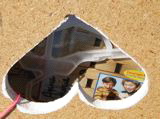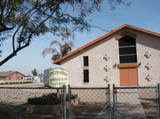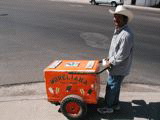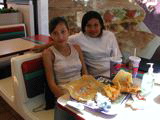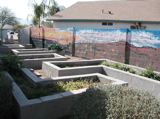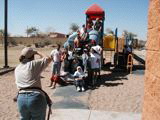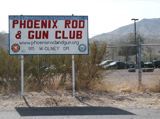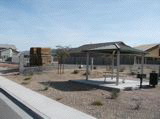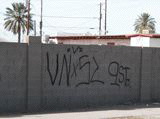Seven Fridays in South Phoenix
Observations, Reflections, and
Photographs by Matthew Alan Lord
The Old in the New
Two
of the real joys of this class are spending time in the field and
writing for a non-academic audience. These elements are present in
this reflective essay, but I ask the reader to pardon a brief foray
into academic writing, in the hopes that it will inform the
subsequent discussion. One of the keys to doing academic research
is to find gaps in understanding and knowledge. Professors
(usually, although sometimes it can be students!) then try to
explain what it is that has been overlooked or understood poorly.
Although I have not made an exhaustive search of what others have
written on the subject, it seems to me that “Dr. K” may be on to a
new, important contribution to urban studies in South Phoenix.
As she identified during our very
first session, what is happening here is not so simple as the
typical gentrification framework used to identify and explain
neighborhood change. Nor is it mere suburban sprawl. It seems this
may be a chance to “third” a duality (as Ed Soja is fond of doing)
and so create a discourse based on trialectics instead of
dialectics. To oversimplify, this means adding a layer of
complexity to conversations that previously were two sided in
nature. Our readings for this week included an excerpt from Neil
Smith’s The New Urban Frontier: Gentrification and the Revanchist
City. Due to the space limitations of our assignment, my
comments herein focus on the ways that the changes in this community
differ from the characterizations set forth in Smith’s piece, and
not the similarities.
Here is Smith’s definition, with
italics added:
Gentrification is
the process, I would begin, by which poor and working-class
neighborhoods in the inner city are refurbished via an
influx of private capital and middle-class homebuyers and
renters-neighborhoods that had previously experienced disinvestments
and a middle-class exodus. The poorest working-class
neighborhoods are getting a remake: capital and the gentry are
coming home, and for some in their wake it is not entirely a
pretty sight.
While
Sociologist Sara Grineski's argument that South Phoenix is
less a spatially defined area than a place in the mind has some
merit, in this
class we are focusing on a very specific site.
This is crucial in terms of Smith’s definition, for he says
gentrification occurs in inner city neighborhoods. Our South
Phoenix is a muddling of such distinctions, an odd juxtaposition of
the urban fringe still laced with farms, and older, urbanized
zones. Likewise, he says gentrification is refurbishment. We see a
little of that, but the overwhelming bulk of change in the
landscape is new construction on former farm fields and “raw land,”
not rehab.
Smith makes the essential point that
gentrification happens in places where the middle class previously
fled but is now returning home. Here one could push the argument if
hearkening back to the days when gentry lived near and north of
the Salt River, but we are talking about the place south of the
Salt. In the history
of the last century-plus, that area has always been the domain
of farmers and the less well off.
The gentry never lived south of the river, and so never fled, and so cannot
now be returning home.
For the second week in a row in the field, I have encountered people
with deep family roots in the are who now occupy the new
suburban-like developments. For me, their stories challenge the simple dichotomy of
gentrification. They
are “the old in the new” of South Phoenix.
